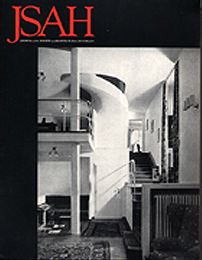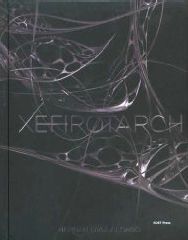Puplications : 2008
 ...
...Isozaki never presents the metaphorical human body as a complete system closed on itself, but on the contrary, it is seen as an assembled organism of amalgamated fragments. The architect is not solely seen as the life-giver, able to create the permanent infrastructure of the city that sustains the growth of its organism. According to him, the architect also needs to foresee the state of decay of the body he has created: death should not be eradicated from the realm of aesthetics, because it enriches the dominant narratives with the poetry of paradox.
Sure enough, for the Metabolists, the short-lived, “soft” cells that are attached to a more permanent infrastructure are simply to be replaced when they turn obsolete. While this is the expression of efficiency, for Isozaki it nevertheless misses the opportunity to relate to the poetics of life, which is never disconnected from the finitude at the basis of each life-cycle: “Since change is half-destructive and half-constructive, it should be permissible for architecture to create the exact appearance of ruins.”
Certainly, Isozaki’s comment does not only apply to the city, but also to the status of human creativity at large –a view that has its conceptual antecedent in European Romantic thought, which Isozaki is well aware of.
“Architecture With or Without Irony”
The cycle of self-positing and self-annihilation paradigmatic of Romantic irony, and important to Isozaki, is theorized in the writings of the German Jena Romantic Friedrich Schlegel. The dilemma presented by Schlegel’s irony arises from the impossibility to express the categorical and the ideal within any single aesthetic creation; any conception is but a fragmentary representation of the continuously evolving reflection of the creator. For that reason, Schlegel holds that it is impossible to reach the highest idea positively; instead, any creation has to forebode its own obliteration: “That, which doesn’t annihilate itself, is worthless.”
He identifies this “complete,” i.e. double-edged, engagement with the historical process in his ideal of art of ancient Greece: “The majesty of antiquity is felt to be indissolubly linked with the images of decline and ruin, for both arise from the same source, -the dominion of instinct, and the spontaneous development of nature. […] Grecian art itself, which rose to absolute perfection, ended also with itself, and it presents a remarkable instance of the perishable nature of merely instinctive greatness.”
In other words, art can only allude to perfection by expressing its aesthetic absolute in a state of decay.
...
 ...
...Philip Johnson did not believe in “principles” of architecture, and his many views and assertions on the subject do not amount to a coherent or synthetic theory to be taught and replicated. If anything, he preferred the stories and anecdotes, with which the architect could publicize his artistic moods to an audience. He constructed his own persona in analogy to an aesthetic object –filled with contradictions, mysterious at times, and never reducible to “just” words. Not least because of his early education in the classics and in philosophy at Harvard before even considering a career as an architect at the age of 34, Johnson liked to borrow loosely from Heraclitus’s wisdom; he agreed with the philosopher who stated that “eyes are better informers than ears,”
and adopted from him the belief that change is the only constancy. The medium of the moving picture therefore appears to be singularly best suited to capture this character, who was passionate about constantly relating his thoughts with the help of words, grimaces as well as gestures. It is as if the narrative aspect of the film medium duplicated his idea of “procession” in architecture, always leading from one surprising event to the next, and never standing still in one place. This is indeed Philip Johnson.
The two documentary films "Philip Johnson: Self Portrait" (John Musili, 1985) and "Philip Johnson: Diary of an Eccentric Architect" (Barbara Wolf, 1996), separated from each other by a decade, hinge on the idea of Johnson thinking aloud about his art. Both films weave in a survey of his wide range of different aesthetic dispositions in his buildings, with the undeniable entertainment value of his relentless commentaries and explanations. In both cases, the spectator is offered a demonstration of this architect’s mercurial wit at the basis of the social persona for which he was notorious by the time of his death in January 2005, at the age of 98.
...
 ...
...In 1986, David Cronenberg directed the horror film The Fly, in which the scientist Seth Brundle slowly realizes that his scientific experiment of spatial teleportation went terribly wrong; Brundle tests the new technological invention of molecular decomposition and re-composition on his own body, and becomes slowly aware of some horrific mutations his anatomy undergoes: His mutilations and dismemberments only gradually reveal an apparent logic behind the hybridization of his human genome, when he states: “I seem to be stricken by a disease with a purpose.”
He understands that in the process of teleportation, the encryption of his body was mixed with the one of a fly, and hence, his metamorphosis starts to make sense to him. At the same time, while turning into a fly, Brundle progressively loses the capacity to think in human terms, that is, to conceptualize what is happening to him.
Not unlike Cronenberg’s aesthetics of horror at the crossing point between technology and biology, Xefirotarch invites architecture back into the Petri Dish of forms. Here too, forms undergo mysterious geometrical alterations, and architectural tissues are bred as if an “other” code had clandestinely infiltrated the process, the nature and purpose of it remaining unbeknownst even to its authors. The enigmatic strangeness of the forms has attracted a wealth of metaphors, including those from the worlds of oceanic depths –monsters, jellyfish, aliens and grotesques –all groping towards finding a workable nomenclature to speak to the intermediary effects that emerge from the experimentations. Without a doubt, Hernan Diaz-Alonso, the lead-scientist of Xefirotarch, invented a machine for teleporting architecture into a different space, which eschews many of the classical themes of architecture’s discipline. A virus with an alleged purpose has been implanted, but the “disease” it has been causing is not diagnosed yet.
Diaz-Alonso’s facility with computer technology stems from his Columbia University training in the nineties, augmented with an undeniable West Coast sensibility, bred on Silicon Valley software and the special effects of the L.A. movie industry. Throughout a diversity of projects, encompassing a wide array of scales and programs, conceptually, Xefirotarch’s work has a categorical emphasis on morphological experimentation. The work ranges from the designs of a hand-watch or an ear-phone to exhibition stands, building extensions, buildings and even master plans for cities. Sometimes Xefirotarch’s forms appear hermetic to intellectual scrutiny, while at other times, they are openly referential of biology and botany. As such, the Concert Hall for Busan in South Korea is quasi-reptilian, the Sur project for MoMA’s P.S.1 is reminiscent of the carcass of a mammal, and the U2 Tower project’s forms in Dublin remain enigmatic and opaque to referential readings. In each case, the peculiar formal aspect of this architecture begs for an investigation of the motivations behind them.
...
